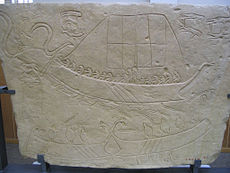

Aliburna was a type of small galley used for raiding and patrols. Originally utilized by the Liburnians, a pirate tribe from Dalmatia, it later became a staple of the Roman navy.[1]

A stone tablet (Stele di Novilara) discovered near ancient Pisaurum (now Pesaro) depicts a liburna in the midst of a naval battle. Dating back to the fifth or sixth century BCE, the image likely portrays a fictional clash between the Liburnian and Picene fleets. The liburna is depicted as a light vessel with a single row of oars, one mast, one sail, and a prow curving outward. Beneath the prow, a rostrum was installed for striking enemy ships below the waterline.
Initially resembling the ancient Greek penteconter,[1] the liburna featured a single bench with 25 oars on each side. However, during the late Roman Republic, it evolved into a bireme with two rows of oars, maintaining its superior speed, agility, and maneuverability compared to triremes.[1] The Romans adopted the liburna design, making it a vital component of the Roman navy, possibly through influence from the Macedonian navy[clarify] in the latter half of the 1st century BCE. Liburnae played a pivotal role in the Battle of ActiuminGreece (31 BCE), cementing the ascent of Augustus as the unrivaled ruler of the Roman Empire.[citation needed]
The design of the liburna distinguished it from battle triremes, quadriremes, and quinqueremes.[1][2] It measured 109 ft (33 m) in length, 5 m (16 ft) in width, with a draft of 1 m (3 ft 3 in). With two rows of oarsmen, each side had 18 oars. Under sail, the ship could achieve speeds of up to 14 knots, while rowing allowed for speeds exceeding 7 knots.[3]
Such a vessel, also employed as a merchantman, might carry passengers, as recounted by Lycinus in the second-century dialogue Love Affairs (§6), traditionally attributed to Lucian: "I had a speedy vessel readied, the kind of bireme used above all by the Liburnians of the Ionian Gulf."[citation needed]

After adopting the liburna, the Romans made modifications to incorporate rams and missile protection, enhancing its suitability for naval use. These enhancements offset the slight reduction in speed.[4] Additionally, the regular Roman military unit needed simplification to ensure smoother operation of the ships. Each ship functioned independently, eliminating the need for the more complex organizational structure typically employed.[5] It's likely that within the navy, liburnae of various sizes were utilized for specific tasks such as scouting and patrolling Roman waters against piracy.[6] The Romans predominantly employed the liburna within the provinces of the empire, where these ships formed the core of the fleets.[7][8][1] Small numbers of liburnae were also integrated into the fleets of Ravenna and Misenum, where many Illyrians, particularly Dalmatae, Liburnians, and Pannonians, served.
Gradually, liburnae became a generic term for various types of Roman ships, including cargo vessels in late antiquity. Tacitus and Suetonius used it interchangeably with "battleship." Inscriptions listed it last among classes of battleships: hexeres, penteres, quadrieres, trieres, liburna.[9]
The liburna lent its name to a natural cove on the west coast of Tuscany. Over time, the cove's name evolved into Livorna and later Livorno — the name of a significant port city that emerged at the site long after the disappearance of this type of ship.
|
| |||||||||||||||||||||||||
|---|---|---|---|---|---|---|---|---|---|---|---|---|---|---|---|---|---|---|---|---|---|---|---|---|---|
| |||||||||||||||||||||||||
| |||||||||||||||||||||||||
| |||||||||||||||||||||||||
| |||||||||||||||||||||||||
| |||||||||||||||||||||||||
| |||||||||||||||||||||||||
| |||||||||||||||||||||||||